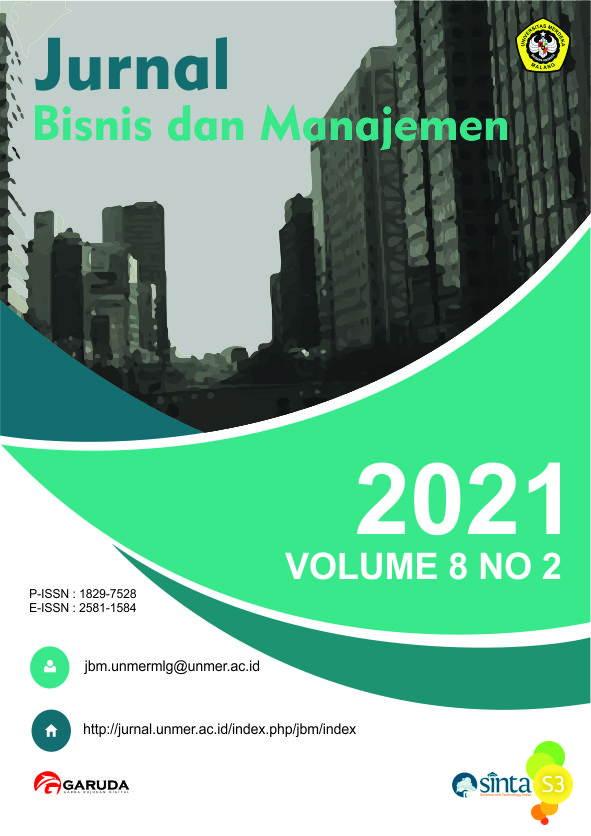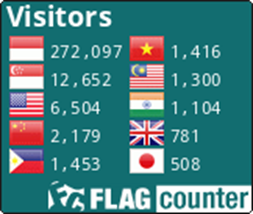Valuasi Saham dan Pengambilan Keputusan Investasi: Perbandingan Metode Absolute dan Metode Relative
DOI:
https://doi.org/10.26905/jbm.v8i2.6127Keywords:
absolute method, investment decision, relative method, stock valuationAbstract
One of the benefits of stock valuation is that it helps investors in making investment decisions. This study aims to compare the intrinsic value of shares using absolute and relative methods. The absolute method used in this study consists of the Dividend Discounted Model (DDM), Discounted Cash Flow (DCF), and Free Cash Flow to Equity (FCFE) while, the relative method consists of Price Earning Ratio (PER), Price to Book Value ( PBV), and Price to Sales (P/S). This study uses four samples of cement sub-sector companies listed on the Indonesia Stock Exchange in 2015-2019. The results based on the measurement of the accuracy of the stock valuation method with Root Mean Squared Error (RMSE) indicate that the DDM approach is the most accurate compared to others. In addition, the results of this study recommend investors sell shares coded INTP because the stock price is included in the overvalued and buy shares coded SMBR, SMGR, and WTON because the stock price is classified as undervalued. However, stock valuation does not fully determine investment success, so investors still have to consider the assumptions of each stock valuation model.
Downloads
References
Afriani, E., & Asma, R. (2019). Analisis Valuasi Harga Saham Dengan Price Earning Ratio, Free Cash Flow To Equity Dan Free Cash Flow To Firm Pada Perusahaan Manufaktur. Jurnal Sains Manajemen Dan Kewirausahaan, 3(2), 111–123.
Audini, M. (2018). Analisis Penilaian Harga Saham Dengan Menggunakan PBV, FCFF Dan FCFE Pada Subsektor Tourism, Restaurant, dan Hotel Yang Terdaftar Di Bursa Efek Indonesia Periode 2015-2017. Sains Manajemen Dan Kewirausahaan, 2(2), 102–106.
Bodie, Z., Kane, A., & Marcus, A. (2008). Investment. New York: McGraw-Hill Education.
Chai, T., & Draxler, R. R. (2014). Root mean square error (RMSE) or mean absolute error (MAE)? -Arguments against avoiding RMSE in the literature. Geoscientific Model Development, 7(3), 1247–1250. https://doi.org/10.5194/gmd-7-1247-2014
Damodaran, A. (2002). Investment Valuation (Tools and Techniques for Determining the Value of Any Asset) (2nd ed.). New York: John Wiley & Sons, Inc.
Darmawan, A., & Budiman, R. (2016). Analisis Fundamental Harga Saham Perusahaan dengan Menggunakan Metode Discounted Cash Flow dan Price Earning ( Studi Pada Perusahaan Multinasional Yang Menjadi Anggota Indeks Sektor Properti di BEI Periode 2012-2016 ). Jurnal Administrasi Bisnis, 63(1), 122–129.
Diniyah, Z. (2021). Analisis Valuasi Saham dalam Pengambilan Keputusan Investasi pada Masa Covid-19 (Studi Kasus pada Indeks Sektoral BEI yang Terdampak Positif dan Negatif Covid-19 Periode 2020). Universitas Negeri Syarif Hidayatullah. Universitas Negeri Syarif Hidayatullah. Retrieved from https://repository.uinjkt.ac.id/dspace/bitstream/123456789/56795/1/SKRIPSI_Zahrotu Diniyah.pdf
Dj, A. M., Artini, L. G. S., & Suarjaya, A. . G. (2012). Pengaruh Kinerja Keuangan Terhadap Nilai Perusahaan pada Perusahaan Manufaktur di Bursa Efek Indonesia. Jurnal Manajemen, Stategi Bisnis, Dan Kewirausahaan, 6(2), 130–138.
Frensidy, B. (2021). Budi Frensidy: Kritis Terhadap Valuasi Saham dan Provokasi Pom-Pom Fakultas Ekonomi dan Bisnis Universitas Indonesia. Retrieved August 19, 2021, from https://www.feb.ui.ac.id/blog/2021/03/01/budi-frensidy-kritis-terhadap-valuasi-saham-dan-provokasi-pom-pom/
Guinan, J. (2010). Investopedia. Jakarta: PT Mizan Publika.
Hasanah, R., & Rusliati, E. (2017). Harga Saham Dengan Metode Dividend Discount Model Dan Price To Book Value. Jurnal Riset Bisnis Dan Manajemen, 10(2), 1. https://doi.org/10.23969/jrbm.v10i2.446
Husnan, S. (2014). Manajemen Keuangan Teori dan Penerapan: Keputusan Jangka Panjang. Yogyakarta: BPFE UGM.
Hutapea, E. C., Poernomoputri, T. P., & Sihombing, P. (2015). Analisis Valuasi Nilai Wajar Saham PT. Adaro Energy Tbk Menggunakan Metode Free Cash Flow To Firm (FCFF). Journal of Applied Finance and Accounting, 5(2), 240–270.
Martia, D. Y., Setyawati, W., Khaerunisa, F., & Hastuti, Y. (2018). Analisis Valuasi Saham PT. Semen Indonesia (Persero) Tbk Dengan Metode Discounted Cash Flow (DCF). Jurnal Aktual Akuntansi Keuangan Bisnis Terapan, 1(2), 160–166.
Natalia, D., E.R, C. W., & Yulita, I. K. (2019). Stock Valuation Analysis Using The Dividend Discount Model, Price Earning Ratio And Price To Book Value For Investmen Decisions. Procuratio: Jurnal Ilmiah Manajemen, 7(3), 276–285.
Noor, M. S., & Satyawan, M. D. (2014). Analisis Penilaian Harga Wajar Saham Studi Kasus pada PT. Multibintang Indonesia. Jurnal Ilmu Manajemen, 2(3), 1095–1105.
Nugraha, E. S., & Sulasmiyati, S. (2017). Analisis Nilai Intrinsik Saham dengan Relative Valuation Techniques (Studi Pada Perusahaan Sub Sektor Rokok yang Terdaftar di Bursa Efek Indonesia Periode 2013 – 2016). Jurnak Akuntansi Bisnis, 52(1), 106–113.
Rahmawati, R., & Nuzula, N. F. (2018). Stock Valuation Using Free Cash Flow to Equity (FCFE ) and Price Earning Ratio (PER) (Study at Companies Listed on LQ-45 Index in Indonesia Stock Exchange Period. Jurnal Administrasi Bisnis, 57(2), 88–97.
Sutjipto, E., Setiawan, W., & Ghozali, I. (2020). Determination of Intrinsic Value: Dividend Discount Model and Discounted Cash Flow Methods in Indonesia Stock Exchange. International Journal of Management (IJM), 11(11), 1842–1852. https://doi.org/10.34218/IJM.11.11.2020.175
Tandelilin, E. (2017). Pasar Modal Manajemen Portofolio & Investasi. Yogyakarta: Kanisius.
Wira, D. (2014). Analisis Fundamental Saham. Jakarta: Salemba Empat.
Downloads
Published
How to Cite
Issue
Section
License
Authors who publish with this journal agree to the following terms:
(1) Copyright of the published articles will be transferred to the journal as the publisher of the manuscripts. Therefore, the author confirms that the copyright has been managed by the journal.
(2) Publisher of Jurnal Bisnis dan Manajemen is University of Merdeka Malang.
(3) The copyright follows Creative Commons Attribution–ShareAlike License (CC BY SA): This license allows to Share — copy and redistribute the material in any medium or format, Adapt — remix, transform, and build upon the material, for any purpose, even commercially.














